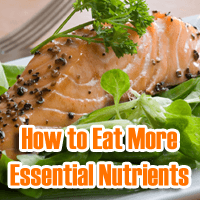
When the U.S. Department of Agriculture came out with its Dietary Guidelines last year, it also published information on the so-called “shortfall nutrients” that Americans are not getting enough of. Are you getting enough of these four important nutrients? Here’s what they are and how to get them through the foods you eat.
 1. Fiber
1. Fiber
Why You Need It: Fiber can help prevent type 2 diabetes, certain types of cancer and heart disease. Research also suggests that consuming fiber-rich foods might boost weight loss by helping you to feel fuller after you eat. But most of us eat only about half as much fiber as we should. Nutrition guidelines recommend that women eat 25 grams daily and men eat 38 grams daily; the average American consumes only about 14 grams.
How to Get It: Load up on plant-based foods–the less processed the better. (Consider this: A medium orange has 3 grams of fiber; a cup of OJ has zero.) Whole grains, such as oatmeal (3 grams per 1/2 cup), and beans (about 6 grams per 1/2 cup) are also great sources.
2. Calcium
Why You Need It: Calcium is important for keeping bones and teeth strong, but it also helps muscles contract, nerves transmit signals, blood clot and blood vessels contract and expand. Adults aged 19 to 50 need 1,000 mg per day; for women 51-plus (and men 70-plus), it’s 1,200 mg daily.
How to Get It: Dairy products are good choices (choose nonfat or low-fat to limit saturated fat), delivering between 300 mg (milk) to 490 mg (nonfat plain yogurt) per 1-cup serving. Some dark leafy greens also offer calcium that’s well absorbed by the body: Kale and collard greens, for example, provide 94 mg and 266 mg per cup, respectively.
3. Potassium
Why You Need It: Potassium is critical for helping nerves transmit signals, muscles contract and cells maintain fluid balance inside and out. Newer scientific evidence demonstrates that potassium helps maintain normal blood pressure.
How to Get It: By eating a variety of fruits and vegetables; they’re full of this nutrient. But according to the U.S. Centers for Disease Control and Prevention, only 32.5 percent of adults eat 2 or more servings of fruit per day and only 26.3 percent eat the recommended 3 or more servings of vegetables per day. Pile on the produce!
4. Vitamin D
Why You Need It: Vitamin D is a fat-soluble nutrient that’s important in bone building and has been linked with lower incidences of cancers and lower rates of immune-related conditions, such as type 1 diabetes and multiple sclerosis. The primary way we get vitamin D is by making it ourselves–UV rays from the sun help us to produce it. In the wintertime, in northern latitudes, many people start to run out of their internal vitamin D stores.
How to Get It: Soak up some sun (ultraviolet, or UV, rays cause skin cells to produce vitamin D). Eat vitamin-D-fortified foods, such as milk, soymilk and cereals. Vitamin D is also found naturally in a few foods: fatty fish, such as salmon, mackerel and sardines, and in egg yolks.
If you live in the northern part of the United States, spend lots of time indoors, and/or slather on the sunscreen anytime you’re outside, you may not be getting enough. Some studies suggest that as many as 7 out of 10 Americans are deficient in vitamin D. To be absolutely sure you’re covering your needs for this nutrient, consider a vitamin D supplement (for folks ages 1 to 70, the recommended amount is 600 International Units).
– Kerri-Ann Jennings, M.S., R.D.
EatingWell is a magazine and website devoted to healthy eating as a way of life. Online at www.eatingwell.com.
(c) 2012 Eating Well, Inc. DISTRIBUTED BY TRIBUNE MEDIA SERVICES, INC.

